Ceki Cards
Indonesian Ceki cards
Ceki cards from Indonesia. The design of these cards is more or less identical to those produced by manufacturers in Malaysia or Belgium. The card second from right on the top row bears the inscription 榮興記 which also occurs in Belgian-made Ceki packs and which could be a maker’s name or simply an auspicious phrase. Most probably both Belgian and Indonesian makers copied their Ceki cards from a common source without knowing what the characters meant (or if they represented language at all). The presence of a bat on the wrapper is easily explained. In Chinese, the words for "Bat" and "fortune" are homonyms - a most appropriate symbol!

Above: Indonesian Ceki cards, c.1901.
ACKNOWLEDGEMENTS
Thanks to Anthony Lee for additional research. Visit his blog here►

Leave a Reply
Your Name
Just nowRelated Articles

Calon Arang • Калон Аранг - Бали
Calon Arang, a figure from 12th-century Javanese and Balinese folklore known as a witch skilled in b...

Marionnettes Wayang
Striking Wayang puppet designs conceived by Youdi des Aubrys from Indonesia, 1985.
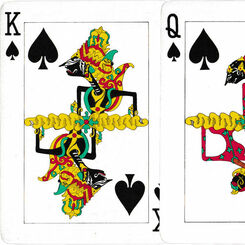
Wayang Bridge Cards
Traditional Wayang puppet theatre characters from Indonesia.
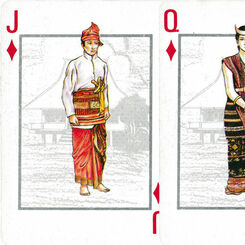
Garuda Indonesia Airline
Souvenir pack from Garuda Indonesia, the national airline of Indonesia, c.1985.

Garuda Indonesia
Souvenir playing cards from Garuda Indonesia Airlines, the national airline of Indonesia.
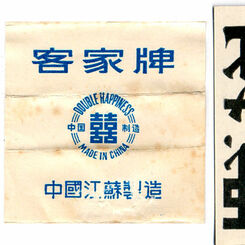
Hakka
“Double Happiness” brand Hakka [客家] playing cards used by Hakka ethnic communities who have a separa...
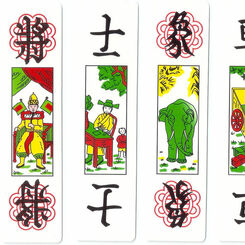
Tam Cúc 三菊
Tam Cúc playing cards from Vietnam (Việt Nam), based on Chinese chess, 2016
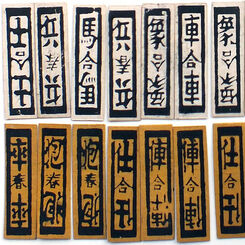
Four Colour Cards / 四色牌 / Si Sek Pai
Four Colour Cards made in Belgium for Far Eastern markets
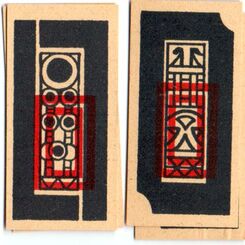
Chi Chi Pai
Chinese “Chi Chi Pai” Playing Cards by Mesmaekers Frères for Far East market.
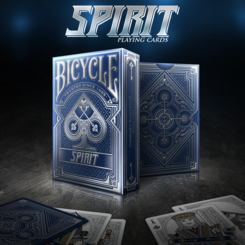
Spirit Playing Cards
Standard court cards show the king, queen and jack looking sideways and diagonal; these elegant Spir...
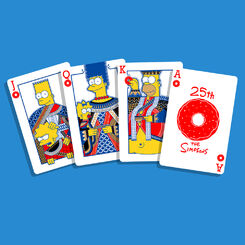
The Simpsons Playing Cards
These Simpsons playing cards were created for a t-shirt competition. Each card representing a member...

Hokkien Four Colour Cards
The characters on the cards are written one way for red and yellow, and another for green and white....
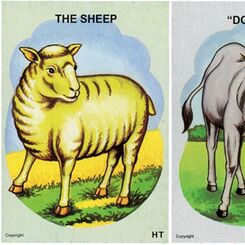
Donkey game from Malaysia
“Donkey” children's card game designed and created by Ooi Yan Hee, manufactured by Hee Trading Co., ...

Hee Trading Co
Hee Trading Co., Malaysia, manufacture board games, jig-saw puzzles, chess sets, games compendiums a...
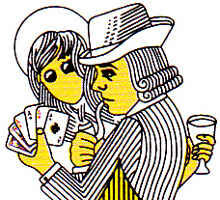
Minnie Patience
Minnie Patience. The backs show images of Mickey & Minnie mouse dancing together.

Mahjongg
Mahjongg is usually played with tiles, which are Chinese playing cards made in solid form...

Playing Cards from Malaysia
Playing Cards from Malaysia.

Double Elephant & Double Dragon
Double Elephant brand Four Colour cards
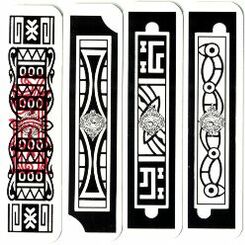
Thai & Siamese Playing Cards
The Portuguese were the first Westerners to trade with Ayutthaya in Thailand in the 16th century. Tr...

Regional Cards: South-Eastern Asia
Indonesia • Malaysia • Singapore • Thailand • Vietnam
Most Popular
Our top articles from the past 60 days


 Your comment here. Your comment here. Your comment here. Your comment here. Your comment here. Your comment here. Your comment here. Your comment here. Your comment here. Your comment here. Your comment here. Your comment here. Your comment here. Your comment here. Your comment here. Your comment here. Your comment here. Your comment here. Your comment here. Your comment here. Your comment here. Your comment here. Your comment here. Your comment here. Your comment here. Your comment here. Your comment here. Your comment here. Your comment here. Your comment here. Your comment here. Your comment here.
Your comment here. Your comment here. Your comment here. Your comment here. Your comment here. Your comment here. Your comment here. Your comment here. Your comment here. Your comment here. Your comment here. Your comment here. Your comment here. Your comment here. Your comment here. Your comment here. Your comment here. Your comment here. Your comment here. Your comment here. Your comment here. Your comment here. Your comment here. Your comment here. Your comment here. Your comment here. Your comment here. Your comment here. Your comment here. Your comment here. Your comment here. Your comment here.




















